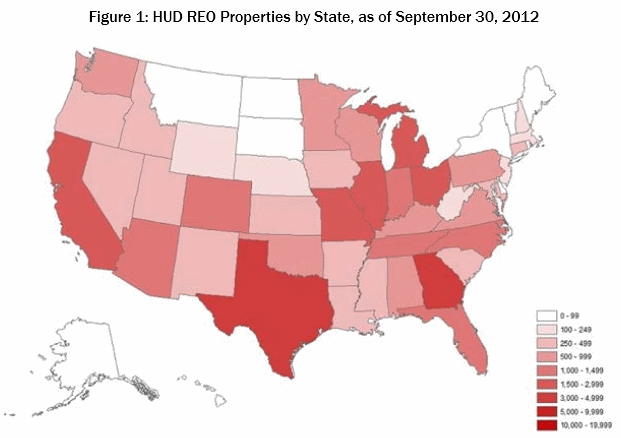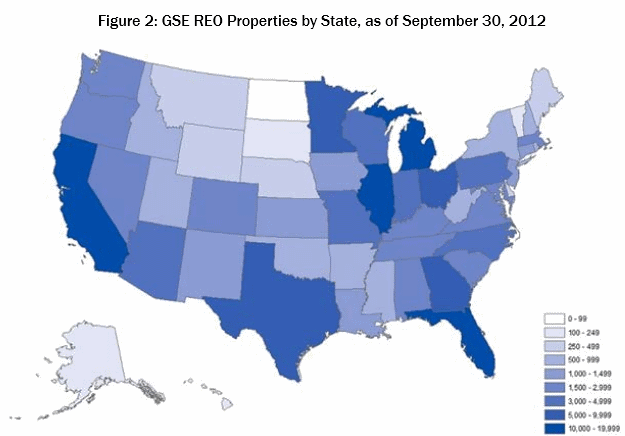As the housing crisis unrolled the Department of Housing and Urban Development (HUD) and the two government sponsored enterprises (GSEs) Freddie Mae and Fannie Mae came into possession of more and more properties thorugh foreclosure. As of September 30, 2012, HUD held 37,445 foreclosed properties (REO) while the GSEs held 158,138. In addition, the "shadow inventory"-residential loans at least 90 days delinquent-totaled 1,708,033 properties, roughly 8.7 times the size of the HUD and GSE REO inventories combined. Even a fraction of the shadow inventory falling into foreclosure could considerably swell HUD and GSE inventories of REO properties.


Because of the volume of this current and potential REO the Offices of Inspector General (OIG) for both HUD and the Federal Housing Finance Agency (FHFA) (conservator of the GSEs) recently produced a report on how HUD and the GSEs are managing and disposing of it.
HUD and the GSEs have created infrastructures to manage and sell their REO and, while these differ among the entities, all involve the use of extensive networks of contractors to perform management tasks to: secure properties to avoid theft, vandalism, and unauthorized use;maintain and repair properties as needed;price properties appropriately through broker price opinions or appraisals and satisfactory promotional efforts; and sell properties to homeowners or investors within a reasonable period.
Long before the housing crisis, HUD outsourced the disposition of its REO inventory to private contractors under its Management and Market (M&M) program. These contractors are responsible for property activity both pre- and post-conveyance, property management, marketing, accounting and reconciliation, and oversight monitoring. Disposition of the REO is administered through Homeownership Centers in Atlanta, Denver, Philadelphia, and Santa Ana, each of which is responsible for a given geographic area.
Without getting into the alphabet soup of HUD management, a manager is assigned to each property to inspect and clean out the property and order an appraisal. If the property is cleared for sale it is listed for 180 days and if not sold within this time frame is offered to local government. If there is an acceptable offer the manager does the necessary title search and other work and clears it for closing.
The GSEs also manage their REO in inventories using a series of contractors:
- Asset management firms which direct certain REO contractors in the performance of day-to-day property management responsibilities.
- Real estate brokers who may, in addition to their marketing responsibilities, manage portions of the REO inventory.
- Attorneys who manage evictions, title issues, and the closing process.
-
Property maintenance companies and repair contractors who do essential cleaning, repairs, and maintenance.
- Appraisers and broker price opinion firms which help the GSEs determine the value and listing prices of the properties.
While the burden of managing these REO inventories is significant enough, the GSEs and HUD must also pay attention to their "shadow inventories," that is properties with mortgages more than 90 days delinquent but which are not yet in foreclosure which, as stated above, have the potential to exponentially expand those inventories.
HUD and the GSEs have taken several steps to shrink their REO inventories. FHA, HUDs housing agency, uses its Office of Assets Sales which was established in 2001 to coordinate disposition of single family and multifamily mortgage notes. These note sales began as a pilot in 2010 and have resulted in the sale of nearly 2,400 single family loans as of April 2013. Notes are sold competitively at a market-determined price generally below the outstanding principal balance to purchasers who agree to delay foreclosure for at least six months. This allows the borrower a chance to get help from the loan servicer to avoid foreclosure.
In September 2012, FHA enhanced the program to include pools of expanded size and use criteria; the revamped program is referred to as the Distressed Asset Stabilization Program. The first offerings from the Distressed Asset Stabilization Program occurred in September 2012 with the latest offering conducted in March 2013. As of April 2013, the program has resulted in the sale of nearly 26,000 mortgages. Another offering is planned for June 2013 with an anticipated sale of 15,000 to 20,000 loans.
In February 2012, FHFA directed Fannie Mae to launch a pilot REO disposition program and bids were solicited from qualified investors to purchase and then rent for a specified period about 2,500 of its foreclosed properties in geographically concentrated areas across the country. Investors were qualified to bid after an extensive review of their financial strength, asset management experience and local expertise. FHFA has targeted especially hard hit areas such as Atlanta, Phoenix, and parts of Florida for the program and several rounds of successful sales have been conducted.
The FHFA OIG said that since becoming their conservator FHFA has consistently listed the large inventories of the GSEs as a critical concern yet did not conduct targeted examinations or other focused reviews until 2011. FHFA-OIG subsequently audited FHFA's oversight of the GSE's REO management and marketing and found they had taken positive supervisory steps but needed to supplement these in the future with more comprehensive risk assessment of, for example, the shadow inventory.
OIG says it plans future assessments of the REO management process including matters such as securing the property, maintenance, valuation, marketing, and sale and is considering several evaluations of FHFA's oversight of the GSE's REO activities with a focus on their ability to handle future workloads and mitigate adverse effects on homeowners and communities.
FHFA OIG will also assess Fannie Mae's pilot REO program if FHFA decides to implement the sale-rental model on a wider scale. That assessment may include whether the program is achieving its expected outcomes and whether it is more cost effective to proceed with the model rather than make sales through the traditional retail channel. OIG may also look at the qualities of the controls to vet potential investors and the GSEs' compliance with the controls and their monitoring and enforcement of investor compliance with the programs rules.
FHFA-OIG also plans to assess FHFA's oversight of single-family property inspections at the GSEs, which are required at various points in the mortgage servicing process, including upon delinquency, in foreclosure, and while managing and disposing of REO. These inspections should determine the overall condition of the property, security of the house, occupancy status, maintenance and capital repair requirements, neighborhood conformity, and other related information. Inspectors must be qualified to perform the inspections.
With this audit and evaluation strategy, FHFA-OIG believes that it will be well positioned to determine whether FHFA is monitoring the GSEs' efforts to mitigate REO risks and costs and the negative impacts of foreclosures on communities and to evaluate the effectiveness of the controls associated with the REO pilot program controls.
The OIGs' report concludes by saying that REO management and disposition are challenging tasks and are likely to become more so as shadow inventory becomes REO and substantial attention must continue to be paid to the manner in which HUD, FHFA, and the GSEs handle such issues.







